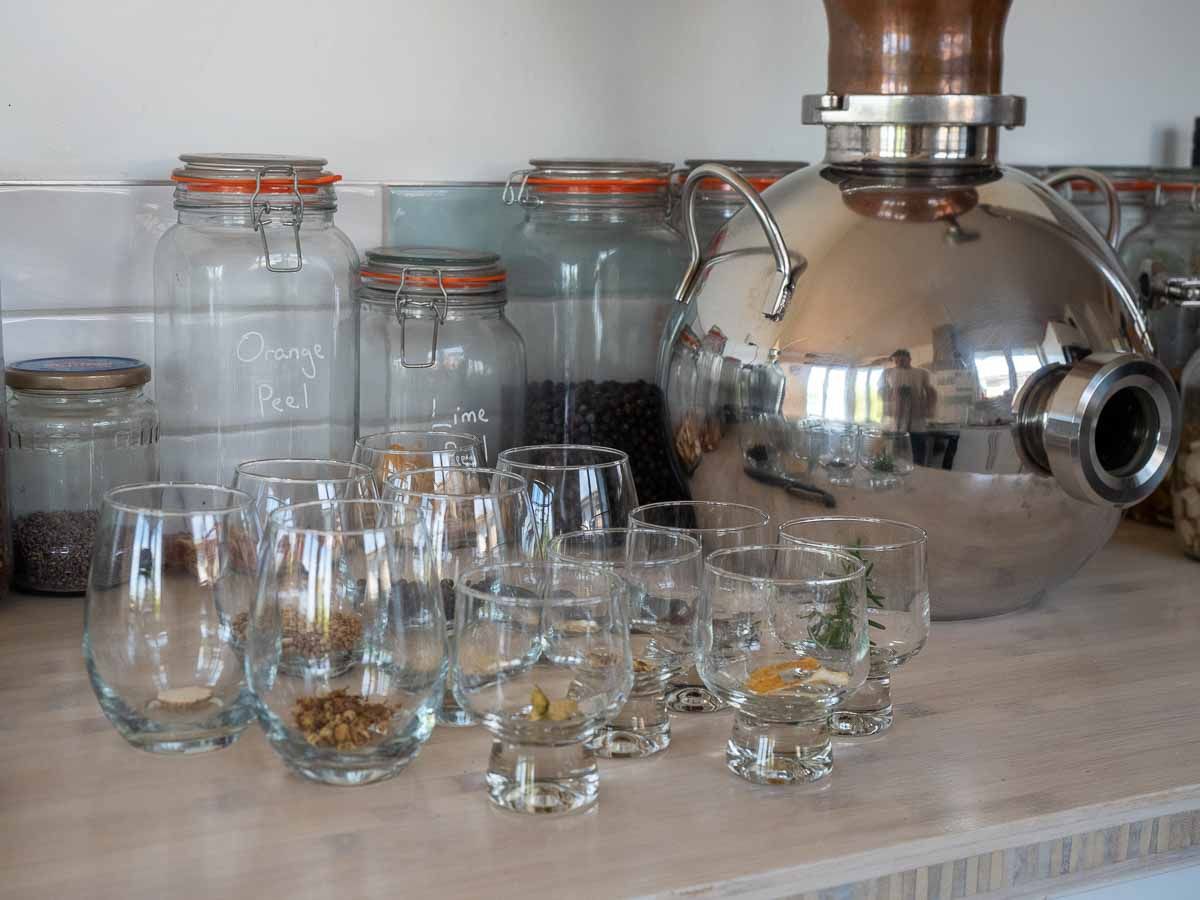Gin, Gin Recipes
Grandma’s Floral Gin Recipe
This recipe is inspired by the perfumy, floral gin flavors popular in the 1940s and 1950s.
I’ve selected botanicals like rosemary, chamomile, licorice, and pepper which together create a rounded
This gin used a combination of the maceration method and vapor infusion method to fully extract the juniper, while handling the floral elements more deliactly.
Table of Contents
Gin Ingredients

| Juniper | 8 |
| Coriander | 6 |
| Angelica Root | 0.5 |
| licorice root. | 0.2 |
| Apricot Kernel | 2g |
| Cardamom | 0.2 |
| Peppercorns | 0.4 |
| Orris Root | 0.5 |
| Lavender | 0.1 |
| Chamomile | 0.4 |
| Hibiscus | 1g (infused) |
| Rosemary | 0.8 Fresh |
| Lime Peel | 0.5 wet |
Instructions
Step 1: Prepare the botanicals
Crush the hard spices using a mortar and pestle.


Step 2: Prepare your neutral spirit

Step 3: Charge your still
Add the crushed spices to the boiler of your still.
Add the rosemary, orris, chamomile, and orange peel into the vapor basket of your still.
Charge with 450ml of high proof neutral spirit. Add 550ml of water to dilute down to a safe distilling proof.

Step 4: Distill
Run the still as per usual. For this recipe I keep the foreshots and stop the still at 90deg Celsius to try eliminate and wet dog tailsey characteristics from the run.

Step 5: Cut and Bottle
Dilute the gin to your desired strength (I recommend 37.5% ABV or 75 proof).
Bottle and enjoy your homemade Grandma’s floral gin!

6 Tips When Making This Floral Gin
Lastly, here’s a couple of tips when it comes to actually making gin.
1. Always work in grams
Measuring ingredients by weight rather than volume provides more accuracy and consistency. Also (as an engineer) a pet peeve of mine is seeing recipes say thinks like ‘1 piece of orange peel’. Like seriously – how big is that?
Like mentioned above, get yourself a good set (or two) of digital scales. One for large quantities of ingredients like Juniper, and one for small amounts of more delicate ingredients.

2. Normalise recipes for grams per litre
This means taking the weight of each ingredient and dividing it by the total volume of the spirits. This allows you to compare recipes easily, regardless of the volume of spirits you’re making.
It also means you can easily scale your recipes. Want to make 10L, simply times everything by 10x! (Yes, ok, in reality it doesn’t quite work that easily but that’s another book)
3. Always dilute with filtered water
This ensures that the water used to dilute the gin does not affect the taste. The topic of exactly what water to use is a big discussion. Do you use distilled water? De-ionized? RO filtered? Or do you collect fresh spring water with a natural terroir.
There’s no simple answer to this unfortunately. It comes down to price, taste, and what you actually have access to. But, I will say that 9 times out of 10 your household tap water won’t be good enough and could impair the taste or look of your gin.
4. Dry vs. wet weight ingredients
It’s important to note whether the recipe calls for dry or wet weight ingredients, as this will affect the amount of the ingredient used.
Generally speaking, all ingredients should be quoted as dried amounts. Dried ingredients are better because they store well, and are more consistent in flavor and concentration.
However, I find some ingredients only work when fresh. For example, dried orange peel doesn’t pop the same as fresh in season citrus – so be aware of this when reading and crafting recipes.
5. Leave overnight to air
Letting the gin sit overnight in an open container can help to release any unwanted flavors or aromas.
Similar to leaving the gin to mature, it also needs to air. This help drive off some of the highly volatile flavors and personally find it takes the edge off the flavor profile.
Note: Leaving it to air for too long can let the gin oxidize which may degrade some of the flavor compounds, so I’d suggest airing for 1 – 7 days.
6. Leave a week to mature before tasting
Gin can change flavor over time, so allowing it to sit for a week before tasting can help you identify any changes in flavor.
This may seem trivial, but I’ve made gins that taste terrible right off the still. I would pack up feeling disappointed that the past few hours of toil had been in vain.
However, when coming back to the gin a day, a week, or 2 weeks later it’s somehow transformed into something really enjoyable.
Final Thoughts
This gin is perfect for sipping neat or mixing in cocktails that complement its floral and herbal notes.
Try it in a classic gin and tonic with a splash of elderflower tonic water for a refreshing twist on a classic cocktail. Garnish with a long peel of cucumber.
Try this recipe? Let me know in the comments below how this one went for you?








